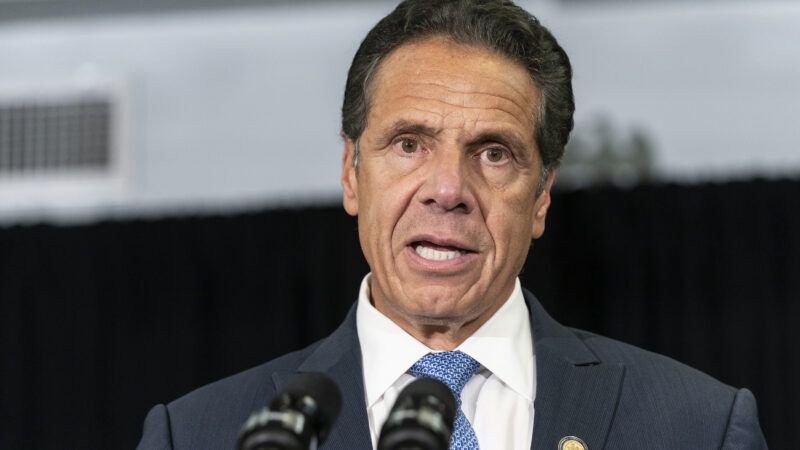Cuomo Warns, Hysterically, That New York Schools Will Become 'Superspreaders'
At a time when the student COVID positivity rate in NYC is 0.01%, the governor is spreading fear that school buildings are death traps.

While urging "dramatic action" to fight the delta variant of COVID, New York Gov. Andrew Cuomo warned Wednesday that "schools can become superspreaders, and in September it will happen."
Telling parents fearful about sending their kids back into school buildings that their classrooms "will" become superspreader events is a counterproductive way to overcome the massive amounts of learning loss that remote K-12 students, who are disproportionately minority and poor, have faced during the pandemic, particularly in the Democratic-voting polities where school closures and distance learning are more prevalent.
Cuomo's messaging is particularly confusing based on what we know about school infectiousness in New York City, home to 71 of the 117 zip codes that the governor has targeted for having comparatively low vaccination and high infection rates. Mayor Bill de Blasio's Department of Education submits students and staff to regular COVID testing, which has continued during the city's "Summer Rising" program, attended by around 200,000 students. And the current positive test rate is close to non-existent.
Of the 21,684 tests administered to Summer Rising participants between July 6 and July 22, all of 28 came back positive. That's a rate of 0.13 percent. The rolling average over the past seven days is just a tick higher: 0.16 percent.
The results are even more striking when you focus on the ostensible beneficiaries of the city's requirement (and the Centers for Disease Control's new recommendation) that all vaccinated people in schools wear masks: unvaccinated kids under age 12. Of the 28 positive tests in New York during that span, 15 were students and 13 were teachers or staff, despite students receiving 2.3 times more tests. So the positive test rate among students in New York City this July has been 0.01 percent. The governor is warning about a possible wave of superspreader events among a population whose current prevalence of infection is a thousand to one.
The delta variant, which is increasing case loads in all 50 states, has advanced earlier and further in other highly vaccinated countries, most notably the United Kingdom. So what have we learned about kids, schools, and infectiousness there? Here's an observation last week from U.K. pediatric infectious disease specialist Alasdair Munro, derived from this government study:
Wow
Despite incessant claims of schools driving this wave, and Delta disproportionately affecting children scaring parents…
Kids age 2 - 11y now lowest estimated prevalence of all ages<35, despite being totally unvaccinated, no masks anywhere and full time school for 4 months pic.twitter.com/XJYAdC85N5
— Alasdair Munro (@apsmunro) July 23, 2021
It is reasonable to assume, and make policy plans around the fact, that kids in schools will be infected at rates higher than 1,000 to 1. The delta variant is more transmissible, and it is currently (and unsurprisingly) ripping through the unvaccinated population first. But as the Centers for Disease Control and Prevention (CDC) has pointed out, there has been no observed difference between the lethality and proportional demographic effects of delta and the original virus. And unvaccinated kids in New York City remain the age cohort with the lowest infection rate, while unvaccinated kids in the United States are the group least likely to be hospitalized or die.
Some people are defending on grounds of vaccine encouragement the hysterical-sounding pronouncements from Cuomo and CDC Director Rochelle Walensky, who on Wednesday made the alarming and evidentiarily unsupported statement that of "every 20 vaccinated people, one or two of them could get a breakthrough infection." But in addition to sowing confusion and making vaccination seem less rewarding, this scaremongering is already having negative impacts on the urgent priority of getting kids back in schools full-time.
American Federation of Teachers President Randi Weingarten, whose fingerprints have been all over closures and evidentiarily unsupported school restrictions in such cities as New York, Los Angeles, Chicago, and Washington, D.C., reacted to the CDC guidance Wednesday by saying, "So the bottom line is, we're going to keep kids safe, we're going to keep our members safe, we're going to try to open up schools, and we're going to move through this political battlefield."
Italics mine, to indicate foreshadowing.
Cuomo's "superspreader" comment, and the likely discouragement it will provide those who are hesitant to send their kids back to school, will come as a deep disappointment for those who have argued that in-person schooling is an urgent priority. As recently as last November, those ranks—at least on paper—included Gov. Cuomo himself.
"Medical research as well as the data from Northeastern states, from across the country, and from around the world make clear that in-person learning is safe when the appropriate protections are in place, even in communities with high transmission rates," said Cuomo, New Jersey Gov. Phil Murphy, Pennsylvania Gov. Tom Wolf, Delaware Gov. John Carney, Connecticut Gov. Ned Lamont, Rhode Island Gov. Gina Raimondo, and Massachusetts Gov. Charlie Baker in a joint statement that month. "In-person learning is the best possible scenario for children, especially those with special needs and from low-income families. There is also growing evidence that the more time children spend outside of school increases the risk of mental health harm and affects their ability to truly learn."
That was the correct take last November, last July, and this July as well. If and when school districts, mayors, and governors screw up a third year of public schooling due to their inability to assess risk, they should be systematically hounded out of office.



Show Comments (103)